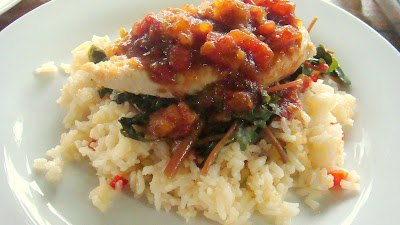This is the first time I have participated in a "
Craving Ellie in My Belly" event. I'm not sure how I heard about it, and I have never heard of Ellie Krieger or her cookbook before, but I really like the idea of creating one of her recipes each week along with several other food bloggers. If all of the recipes are as delicious as this first one was, we are going to be looking forward to it a lot each week! This weeks recipe was chosen by Marthe of
Culinary Delights.
My very first entry is this yummy looking
Balsamic Chicken with Baby Spinach dish. Of course, I had to make a couple of minor substitutions for things that aren't available here, but regardless, the end result was superb.
Balsamic Chicken with Baby Spinach
Recipe By: Ellie Krieger
Serving Size: 4
Ingredients:

1 tablespoon olive oil
3 cloves garlic ; chopped (I added a bit more)
2 (8-ounce) boneless ; skinless chicken breasts, halved (I partially thawed two of the chicken breasts from my freezer before cutting in half)
8 ounces baby spinach (I substituted a local wild herb called "verdolaga")
2 tablespoons balsamic vinegar
1/3 cup low-sodium chicken broth (I used broth from my last baked chicken)
1 cup low-sodium canned chopped tomatoes with juice (We can't buy canned tomatoes here, which is great because I like cooking with fresh ... I peeled and chopped two rosy red tomatoes)
2 cups whole wheat couscous ; cooked (I have never seen couscous in Peten, so substituted white rice cooked with chopped onion and sweet red pepper)
Instructions:
Heat a large saute pan over medium-high heat. Add the olive oil and heat. Add the garlic and cook for 1 minute.

Add the chicken and cook about 4 minutes per side, or until cooked through and juices run clear.

Remove the chicken and set aside. To the same pan, add the spinach and cook just until wilted, about 1 to 2 minutes.

Remove from the pan and set aside. Lower the heat to medium and add the balsamic vinegar and chicken broth to the pan and stir, scraping the bottom of the pan to remove any browned bits.

Add the tomatoes,

bring to a simmer and cook 3 to 5 minutes.

Place the couscous (or rice) on plates.

Top with the spinach, (or verdolaga)

chicken

and balsamic-tomato sauce.

and ... TA-DA ...

The Verdict:
It was SUPERB! I was worried that the flavor of the balsamic vinegar wouldn't be strong enough for my tastes, but I found the more subtle back-flavor with the tomato much more appealing, and didn't add any extra at the table. The only change I might make is to add a bit more verdolaga (or whatever green one is using). I will most definitely be putting this on my "do again" list!

Check out "Craving Ellie in My Belly" for the list of other participants who have created this dish today, or to enroll to participate yourself.
Read More...
Summary only...







































